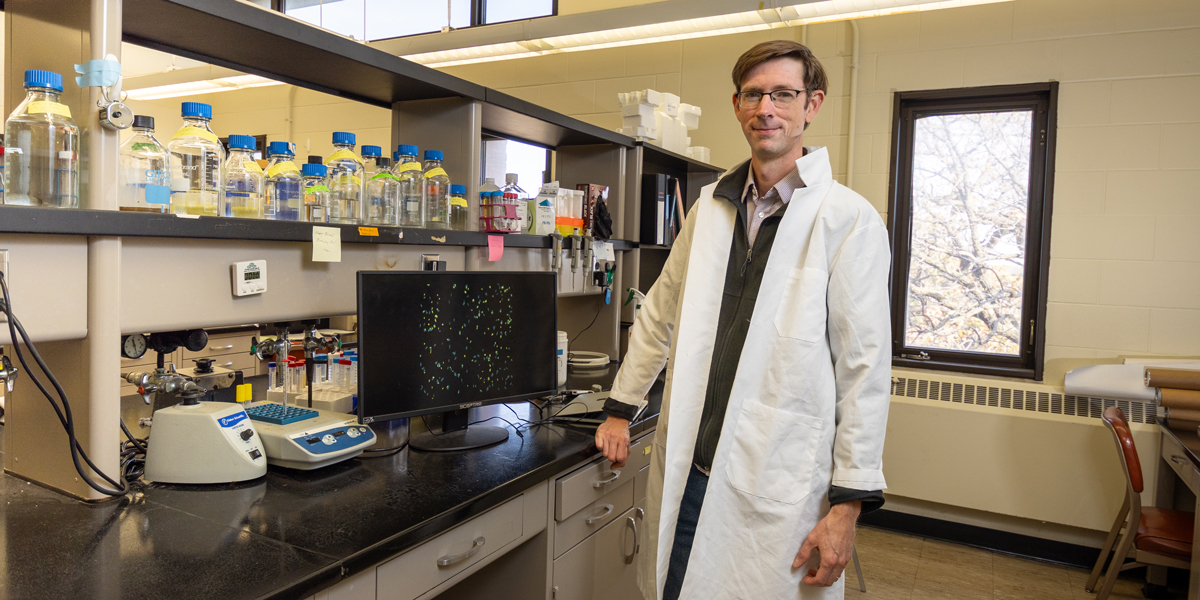
In the human microbiome, hundreds of bacterial species live in chockablock communities. Yet when researchers study antibiotic persistence—a phenomenon that occurs when a small percentage of a bacterial population survives antibiotic treatments without evolving genetic resistance—the studies generally involve a single species cultured in a shaken test tube. In other words, the standard experimental design cannot account for real-world interactions between microbial neighbors.
Xianyi Xiong (B.S. Microbiology, ’20, M.S. Microbial Engineering, ’22) set out to complicate this picture. “We wanted to figure out, first of all, what will happen to antibiotic efficacy if we consider interactions on a surface between bacterial species and their neighbors?” he explains.
Xiong worked with William Harcombe, an associate professor in the Department of Ecology, Evolution and Behavior, to investigate a synthetic ecological interaction between two bacterial species: E. coli and Salmonella enterica. The bacteria were engaged in a cross-feeding relationship, where each species secreted a nutrient needed by the other to grow. The research findings—recently published in The ISME Journal—reveal that, for bacteria, neighbors can be the difference between survival and death under antibiotic treatment.
Antibiotic persistence is challenging to study because it involves temporary differences between a small number of cells within a genetically identical population. So, isolating factors that allow certain representatives of a population to persist while others succumb to an antibiotic requires observations of individual cells. “You have to get measurements on thousands to hundreds of thousands of cells,” Harcombe explains. “Getting those measurements for a single species is hard, and then when you add in the complexity of additional species, it further increases the challenges.”
At the outset, Xiong and Harcombe found that when E. coli and Salmonella were grown together in structured communities on agar plates and exposed to an antibiotic, E. coli formed 55 times more persistent cells than when it was grown by itself. When the researchers repeated the same tests with bacteria cultured in test tubes that were shaken to disrupt the structure of the bacterial community, the staggering 55-fold advantage vanished, indicating that the spatial relationship between the species was essential for persistence.
To isolate the factors contributing to this dynamic, the researchers needed to analyze individual cells responding to the antibiotic treatment in real time. To do so, they processed samples at the University Imaging Centers, which is equipped with microscopy equipment that could photograph the bacterial communities on a surface every 20 minutes over the course of seven hours. “As they grow, we're able to see individual cells expanding and eventually becoming two cells,” Xiong says. “When the cells die due to antibiotics, we’re also able to see individual cells disappearing from our view.”
These shifting constellations ultimately revealed a previously undocumented role neighboring bacteria play in helping one another persist during antibiotic treatments. E. coli cells were more likely to survive when their Salmonella neighbors had died, because the loss of the cross-feeding nutrient kept the E. coli cells dormant and persistent against antibiotics. The researchers further worked with coauthor Hans Othmer, a professor in the School of Mathematics, to design a mathematical model for predicting interactions between bacteria engaged in cross-feeding with their neighbors.
“Many infections are polymicrobial,” Xiong explains. “These microbial helpers of the pathogens are greatly neglected, which makes it challenging for us to understand what is the true danger of the infection.” By showcasing the importance of neighbors in these complex microbial communities, the research may eventually inform new strategies for safeguarding human health. — Jonathan Damery